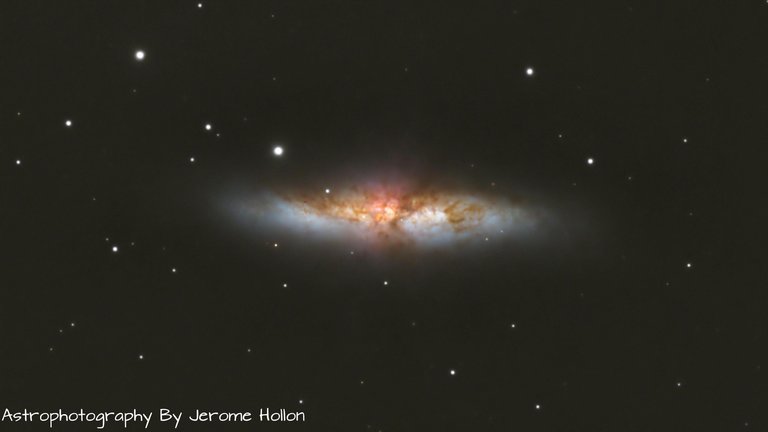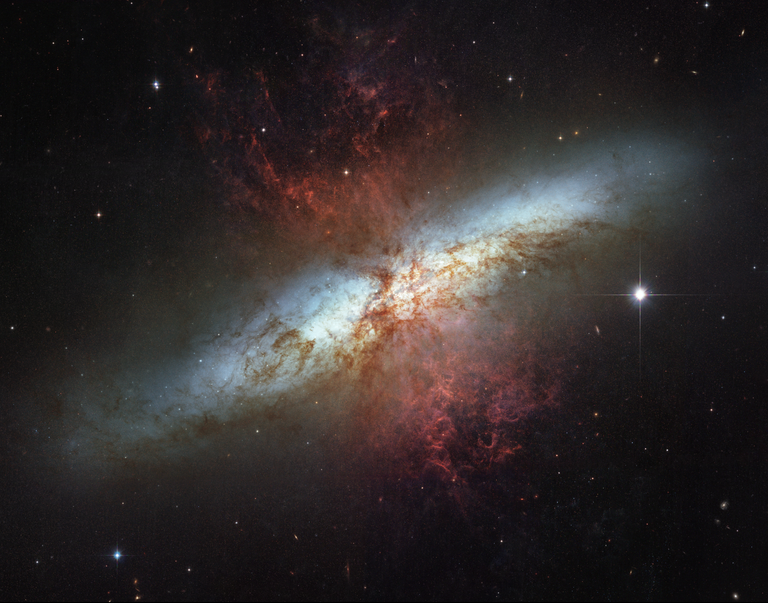Cigar Galaxy - A Stellar Nursery

This is an astrophotography series, personally captured and edited by the author. This image is the result of 7.2 hours of imaging time on the target.
The Cigar Galaxy is a unique starburst type galaxy. Even though it doesn’t look that big in this photo, it is roughly the same size as the milkyway galaxy, both around 40k lightyears across. The Cigar Galaxy only look so small because it’s somewhere between 11.4 and 12.4 million lightyears away. That’s pretty damn far. The Cigar galaxy is also a spiral galaxy, just like our home, but we see it edge on, apparently the spiral tips are visible in Near Infrared images, but I don’t have that type of camera.
What is a Starburst Galaxy?
 Hubble Mosaic of the Cigar Galaxy
Hubble Mosaic of the Cigar Galaxy
I mentioned earlier that this is a “starburst type galaxy” but what does that mean? When we classify a galaxy as a starburst galaxy, what astronomers are saying is that the galaxy is undergoing extreme rates of stellar formation. The Cigar Galaxy is making new stars 10 times faster than the milky way.
The image on the right is an image from the Hubble Telescope of the Cigar Galaxy. In it you see red filaments coming out of the center of the galaxy. These tendrils are only barely visible in my image. These filaments are ionized hydrogen gas, and they extend around 10,000 light years in each direction. The hydrogen gas for these filaments are ejected gas that happens during star formation. Once a star ignites, it pushes a lot of the gas in it’s vicinity out of its gravitational influence, and that’s what we see here. Next year, if I image this same galaxy again, I’ll use my narrowband hydrogen alpha filter to pickup the filaments better. Unfortunately since I only imaged this time with broadband filters, we only see the visible light spectrum. 75% of the hydrogen gas emission spectrum is outside the visible spectrum and falls just barely into infrared, so it’s not visible with my red filter.
Why is the Cigar Galaxy Making So Many Stars?
 An old photo of mine of the M81/M82 Galaxy Group
An old photo of mine of the M81/M82 Galaxy Group
The reason the Cigar Galaxy has so much star formation activity is because of it’s neighbor, Bode’s Galaxy (M81). They’re currently about 150,000 lightyears apart and had a near miss at colliding 500 million years ago that kicked off a lot of star formation. Eventually though, in a few billion years, they will merge into one massive galaxy, much like what will happen between the Milky Way and our cosmic neighbor the Andromeda galaxy.
The image on the left shows both Bode’s Galaxy and the Cigar Galaxy and is from an old capture from 2022 with a 600mm focal length telescope.
 The same Cigar Galaxy at 600mm of focal length
The same Cigar Galaxy at 600mm of focal length
To the right a great example of how focal length matters. At 600mm focal length you have a lot less detail than the 2800mm of the main image attached to this page. It’s also a pretty decent sample of how much improvement I’ve had, both in image acquisition and post processing.
The color balance is off here, a deconvolution step has left odd artifacts around the bright stars, and pinched optics has takes the stars out of circular. All things that aren’t present in my images for the past couple of years. I’m still proud of it though, warts and all.
Originally posted on my website, check it out and other content here: https://www.jeromehollon.com/astro/2025-02-21-m82/
Congratulations @astronerd! You have completed the following achievement on the Hive blockchain And have been rewarded with New badge(s)
Your next target is to reach 99000 upvotes.
You can view your badges on your board and compare yourself to others in the Ranking
If you no longer want to receive notifications, reply to this comment with the word
STOPThe light display was so beautiful I really enjoyed it ❤️